Complete Solutions to All Questions of chapter CURRENT ELECTRICITY of Class 11 book with complete answers and questions
| Class 11 | PHYSICS |
| Chapter | CURRENT ELECTRICITY |
| DC PANDEY MASTER PROBLEM PACKAGE | All Questions |
| Number Of Questions | 100 |
| Academic Year | 2023-24 |
The current density in a wire is `10A//cm^(2)` and the electric field in the wire is 5 V/cm. If p = resistivity of material, `sigma`= conductivity of the material then (in SI unit)
View SolutionA resistor of resistance R is connected to a cell internal resistance `5 Omega`. The value of R is varied from ` 1 Omega` to `5 Omega`. The power consumed by R
View SolutionFind the current through the `10(Omega)`resistor shown in figure.

View SolutionEach resistance shown in the network is in ohm. Current through the resistor `3 Omega` is 0.25 A. The input voltage 'V' is equal to

View SolutionIn the figure shown, each resistor is of `20 Omega` and the cell has emf 10 volt with negligible internal resistance. Then rate of joule heating in the circuit is (in watts)
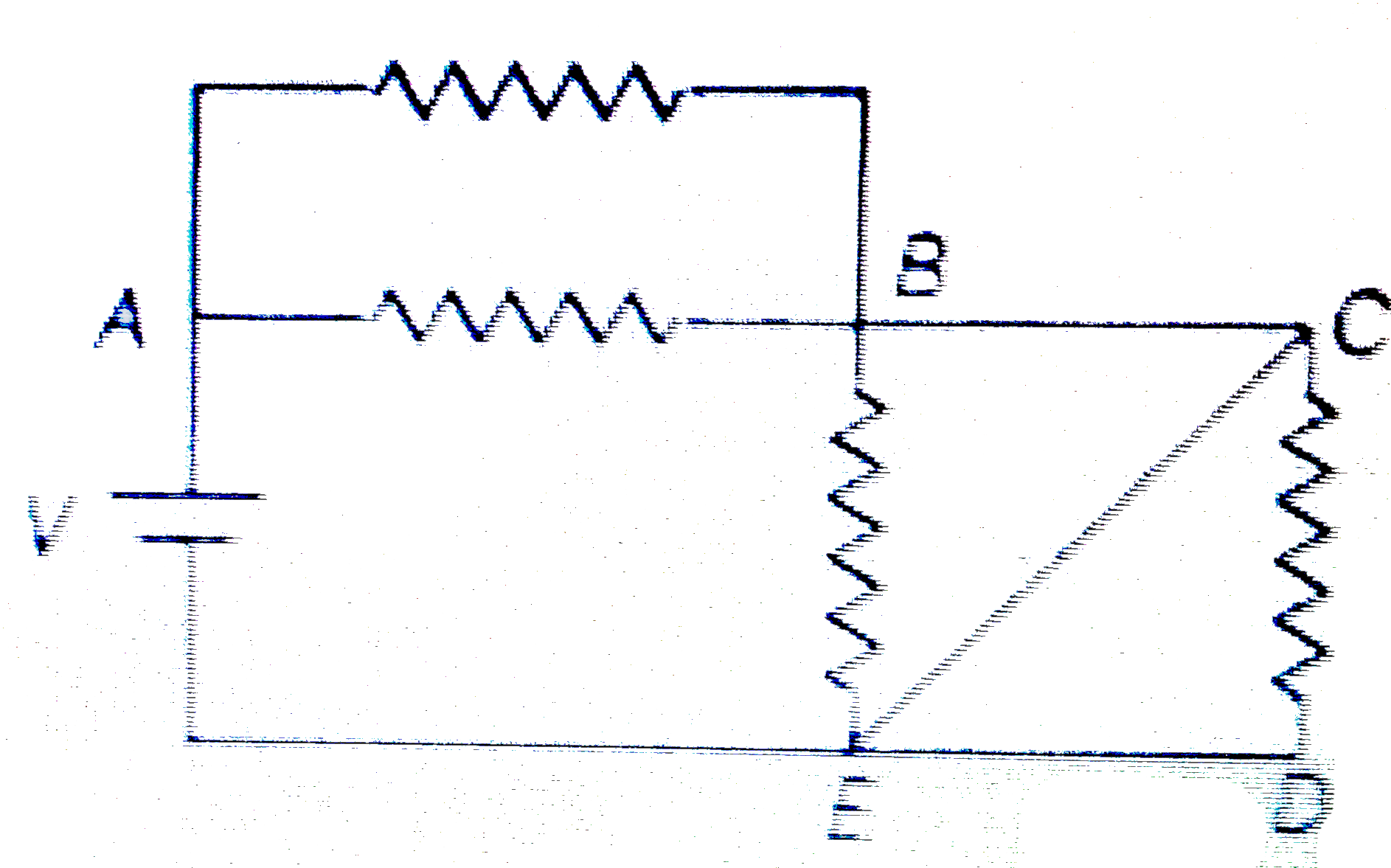
View SolutionFour identical bulbs each rated 100 watt, 220 volts are connected across a battery as shown. The total electric power consumed by the bulbs is:

View SolutionThe reading of voltmeter is

View SolutionThe ammeter shown in figure consists of a `480 Omega` coil connected in parallel to `20 Omega` shunt. Find the reading of the ammeter

View SolutionWhen a galvanometer is shunted with a `4 Omega` resistance, the deflection is reduced to one-fifth. If the galvanometer is further shunted with a `2 Omega` wire, determine current in galvanometer now if initially current in galvanometer is `I_(0)` (given main current remains same).
View SolutionIn the figure shown the current flowing `2 R` is:

View SolutionThe equivalent resistance between the points A and B is:

View SolutionIn the circuit shown, what is the potential different `V_(PQ)` ?

View SolutionWhich of the following wiring diagrams could be used to experimentally determine `R` using ohm's law? Assume an ideal voltmeter and an ideal ammeter.
View SolutionIn the given circuit current flowing through the resistance `20Omega` is `0.3A,` while the ammeter reads 0.8 A. What is the value of `R_1`

View SolutionPower generated across a uniform wire connected across a supply is `H`. If the wire is cut into `n` equal parts and all the parts are connected in parallel across the same supply, the total power generated in the wire is
View SolutionRate of dissipation of Joule's heat in resistance per unit volume is (symbols have usual meaning)
View SolutionThe variation of current `(I)` and voltage `(V)` is as shown in figure `A`. The variation of power `P` with current `I` is best shown by which of the following graph

View SolutionSix resistors each of 10 ohm are connected shown. The equivalent resistance between points X and Y is

View SolutionThirteen resistances each of resistance `R` ohm are connected in the circuit as shown in the figure below. The effective resistance between `A` and `B` is

View SolutionIn the given network, the euqivalent resistance between A and B is

View SolutionThe equivalent resistance between points A and B

View SolutionA conductor with rectangular cross section has dimensions `(axx2axx4a)` as shown in figure. Resistance across AB is x, across CD is y and across EF is z. Then

View SolutionWhich of the following has the maximum resistance?
View SolutionThe length of a potentiometer wire is `l`. A cell of emf `E` is balanced at a length l/3 from the positive end of the wire. If the length of the wire is increased by l/2. At what distance will the same cell give a balance point.
View SolutionA cell develops the same power across two resistances `R_(1)` and `R_(2)` separately. The internal resistance of the cell is
View SolutionTwo wires of same dimension but resistivity `p_(1)` and `p_(2)` are connected in series. The equivalent resistivity of the combination is
View SolutionCurrent passing through `3 Omega` resistance is
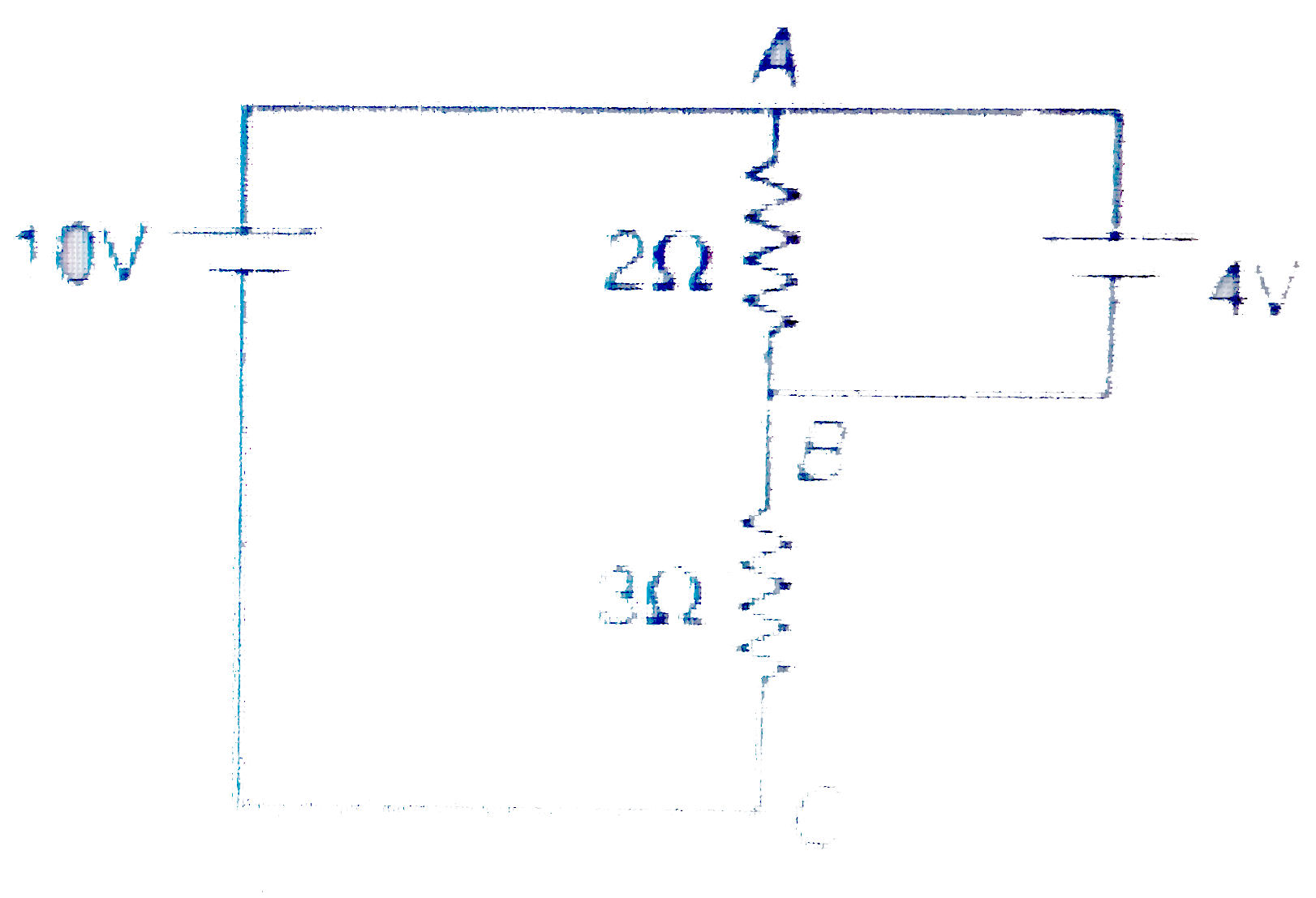
View SolutionCurrent passing through `1 Omega` resistance is zero. Then the emf E is

View SolutionAs the switch S is closed in the circuit shown in figure, current passed through it is

View SolutionIn the circuit shown in figure

View SolutionFind equivalent resistance between A and B

View SolutionTwo identical batteries, each having emf of 1.8 V and of equal internal resistances are connected as shown in the figure. Potential difference between A and B will be equal to (Ignore the resistance of lead wires)

View SolutionIn the two circuits shown in figure

View SolutionThe net resistance between points P and Q in the circuit shown in figure is

View SolutionCurrent in `3 Omega` resistance is

View SolutionA galvanometer of resistance `R_(G)` is to be converted into an ammeter, with the help of a shunt of resistance R. If the ratio of the heat dissipated through galvanometer and shunt is 3:4, then
View SolutionThe equivalent resistance between points A and B

View SolutionIn the circuit shown in figure, each resistance is Net resistance between points A and B is

View SolutionIn the same figure, equivalent resistance between points A and D is
View SolutionEach resistance of the circuit shown in figure is r. The equivalent resistance between A and B is

View SolutionAs shown, the circuit is made of 8 different resistance. It is found that when `R_(1) = 4 Omega`, the resistance between A and B is `2 Omega`. Now replace `R_(1)` by a `6 Omega` resistor, what is the resistance between A and B ?

View SolutionResistance of each resistor is R. Then the equivalent resistance across A and B is

View SolutionIn the given circuit the power dissipated through resistance `R_(1) = 9 Omega` is `P_(1)`, when switch `S_(1)` is closed and `S_(2)` is opened and the power dissipated through resistance `R_(2) = 4 Omega` is `P_(2)`, when switch `S_(2)` is closed and `S_(1)` is opened. If `P_(1) = P_(2)`, then r is equl to :

View SolutionA copper disc and a carbon disc of same radius are assembled alternately and co-axially to make a cylindrical conductor whose temperature coefficient conductor whose temperature coefficient of resistance is almost equal to zero. Ratio of thickness of the copper and the carbon disc is (neglect change in length. `alpha_(CU)` and `-alpha_(C)` represent the temperature coefficients of resistivities and `p_(cu)` carbon at room temperature respectively)
View SolutionFind equivalent resistance between A and B
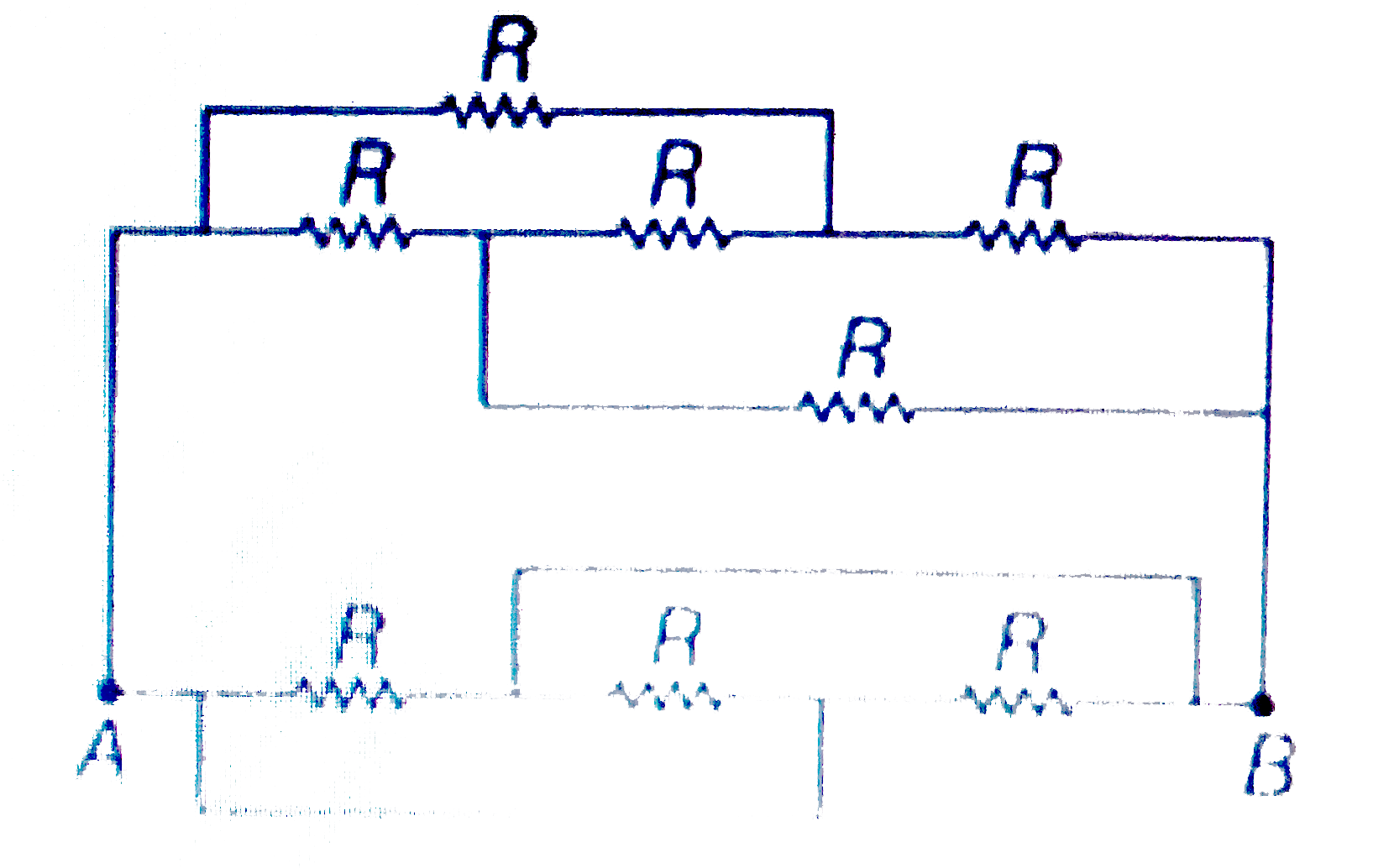
View SolutionFind equivalent resistance between A and D

View SolutionCalculate equivalent resistance between A and C

View SolutionIn the circuit shown below, V should be:

View SolutionEquivalent resistance between A and B is

View SolutionIn the circuit shown in figure, power developed across `1 Omega, 2 Omega` and `3 Omega` resistance are in the ratio of

View SolutionA moving coil galvanometer of resistance `20 Omega` gives a full scale deflection when a current of `1mA` is passed through it. It is to be converted into an ammeter reading `20 A` on full scale. But the shunt of `0.005 Omega` only is available. What resistance should be connected in series with the galvanometer coil?
View SolutionMaximum power developed across variable resistance R in the circuit shown in figure is
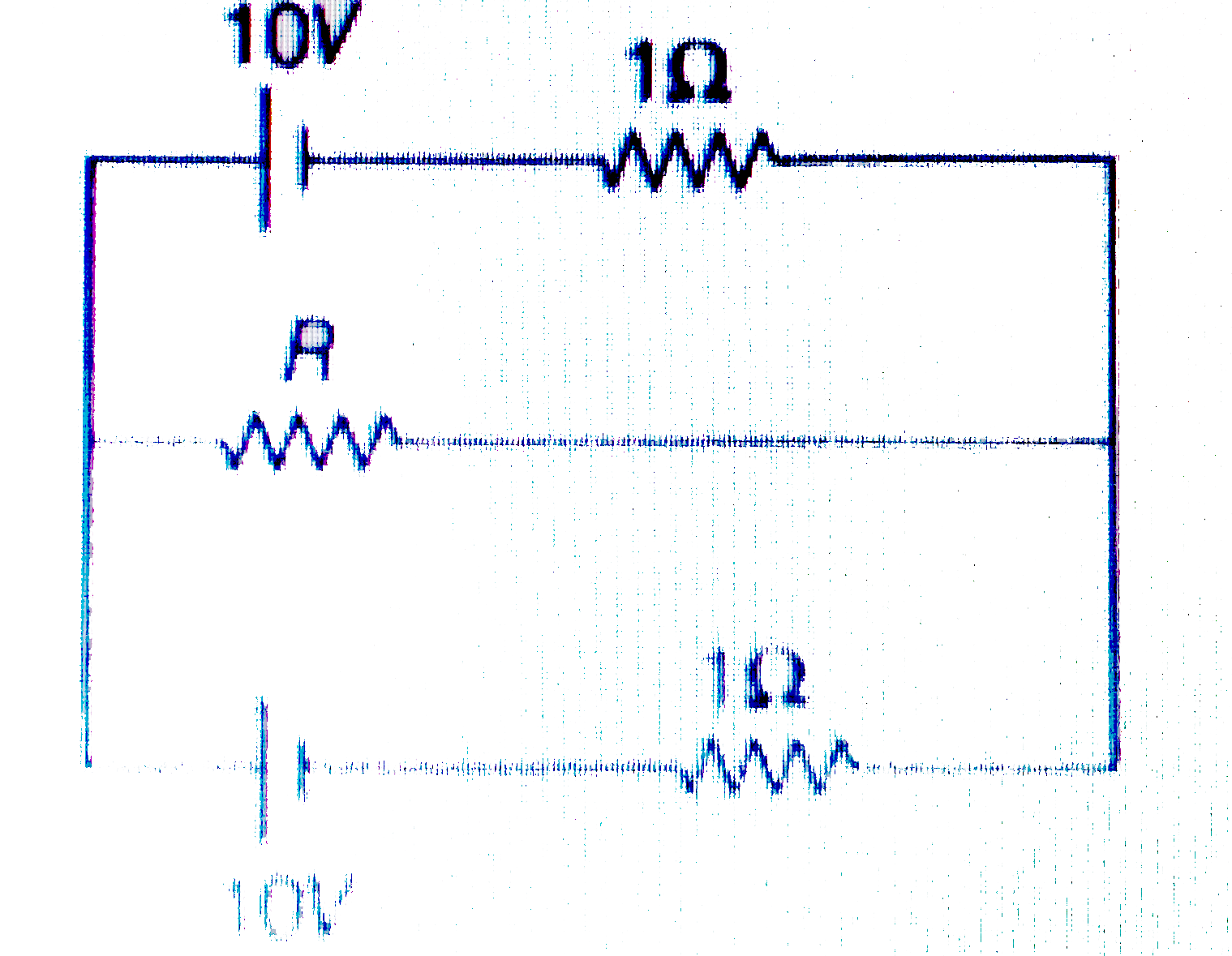
View SolutionResistance of a resistor at temperature `t^@C` is `R_t =R_0 (1+alphat + betat^2)`, where `R_0` is the resistance at `0^@C`. The temperature coefficient of resistance at temperature `t^@C` is
View SolutionPotential different across the terminals of the battery shown in figure is
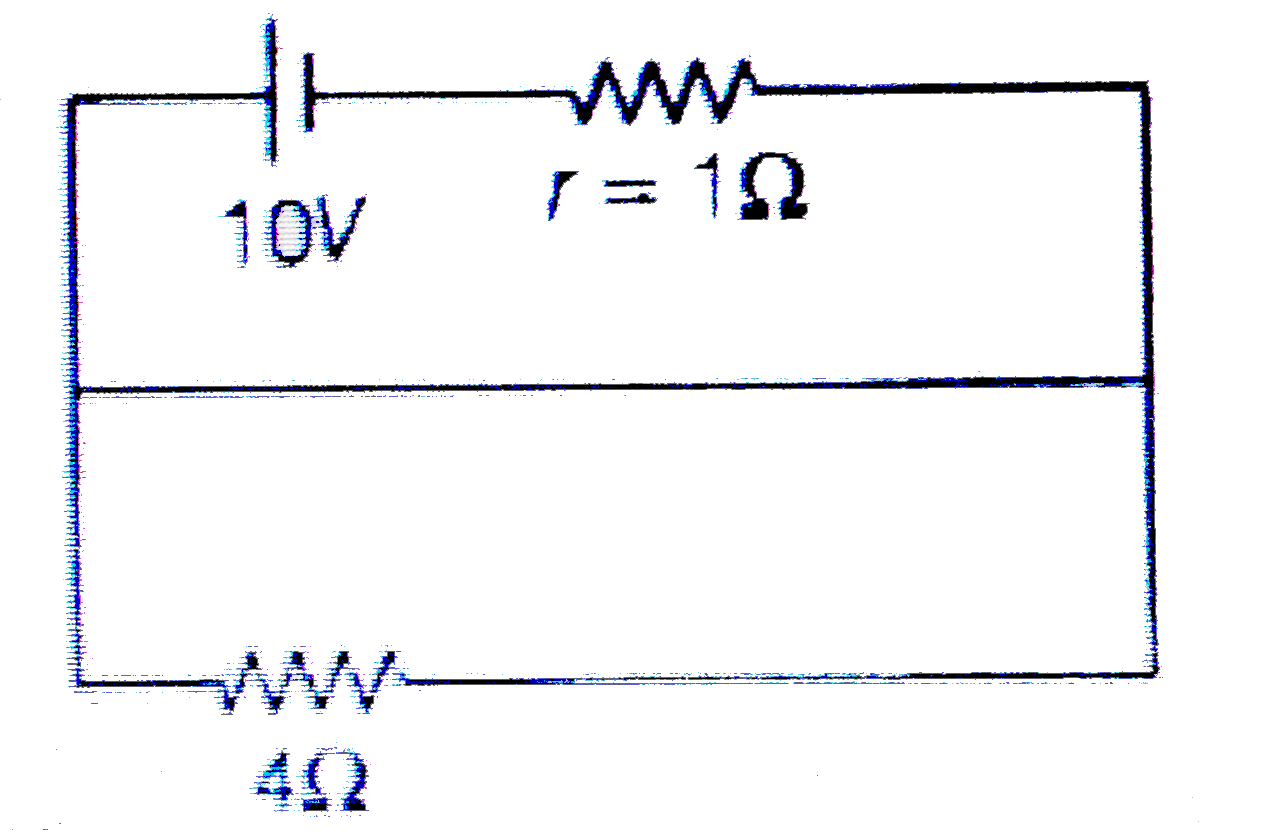
View SolutionThe emf of the battery shown in figure is

View SolutionA voltmeter with resistance `500 Omega` is used to measure the emf of a cell of internal resistance `4 Omega`. The percentage error in the reading of the voltmeter will be
View SolutionIn the figure, the potentiometer wire of length `l = 100 cm` and resistance `9 Omega` is joined to a cell of emf cell of emf `E_(2) = 5 V` and internal resistance `r_(2) = 2 V` is connected as shown. The galvanometer is show no deflection when the length AC is

View SolutionThe potential difference across the terminals of a battery is 10 V when there is a current of 3 A in the battery from the negative to the positive terminal. When the current is 2A in the reverse direction, the potential difference becomes 15 V. The internal resistance of the battery is
View SolutionIn the circuit shown, if a wire is connected between points A and B. How much current will flow through that wire?
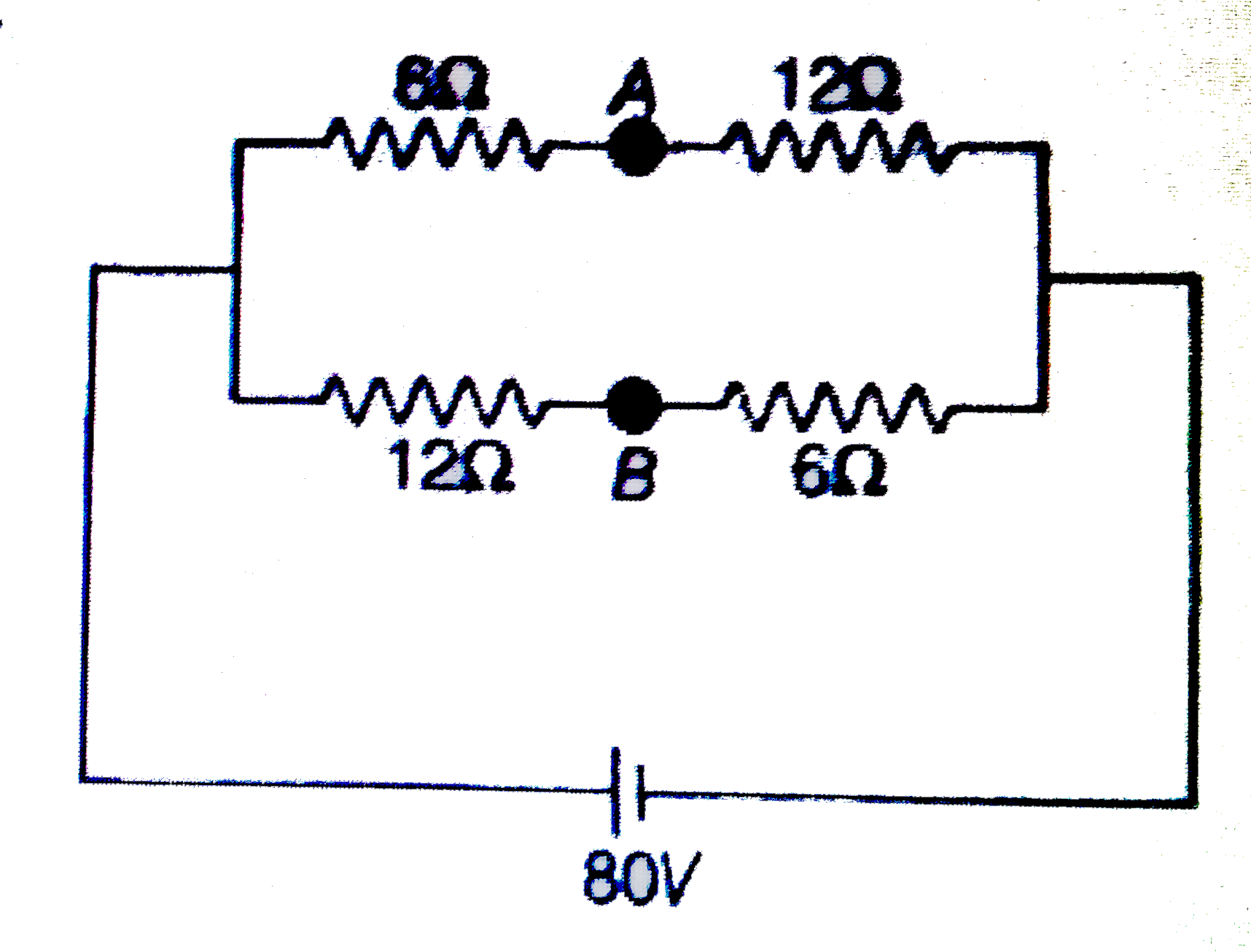
View SolutionEight resistances each of resistance `5 Omega` are connected in the circuit as shown in figure. The equivalent resistance between A and B is

View SolutionTwelve resistors each of resistance `1 Omega` are connected in the circuit shown in figure. Net resistance between point A and H would be

View Solution`n` identical cells are joined in series with two cells A and B with reversed polarities. EMF of each cell is E and internal resistance is r. Potential difference across cell A or B is (n > 4)
View SolutionFind the resistor in which maximum heat will be produced.

View SolutionThe potential difference between the points A and B in the circuit shown is 16 V, Which is/are the correct statement(s) out of the following?

View SolutionUnder what condition, the current passing through the resistance R can be increased by short - circuiting the battery of emf `E_2` The internal resistances of the two batteries are `r_1 and r_2,` respectively.

View SolutionIn the circuit shown in figure, reading of voltmeter is `V_1` when only `S_1` is closed, reading of voltmeter is `V_2` when only `S_2` is closed, and reading of voltmeter is `V_3` when both `S_1 and S_2` are closed. Then .

View SolutionA resistance R carries a current i. The power lost to the surrounding is `lambda (theta - theta_(0))`. Here, `lambda` is a constant, `theta` is temperature of the resistance and `theta_(0)` is the temperature of the atmosphere. If the corfficient of linear expansion is `alpha`. The strain in the resistance is
View SolutionFor what value of R in the circuit as shown, current passing through `4 Omega` resistance will be zero

View SolutionIn the circuit shown, when switch `S_(1)` is closed and `S_(2)` is open, the ideal voltmeter shows a reaiding of `18 V`. When switch `S_(2)` is closed and `S_(1)` is open, the reading of voltmeter is `24 V`. When `S_(1)` and `S_(2)` both are closed, the voltmeter reading will be
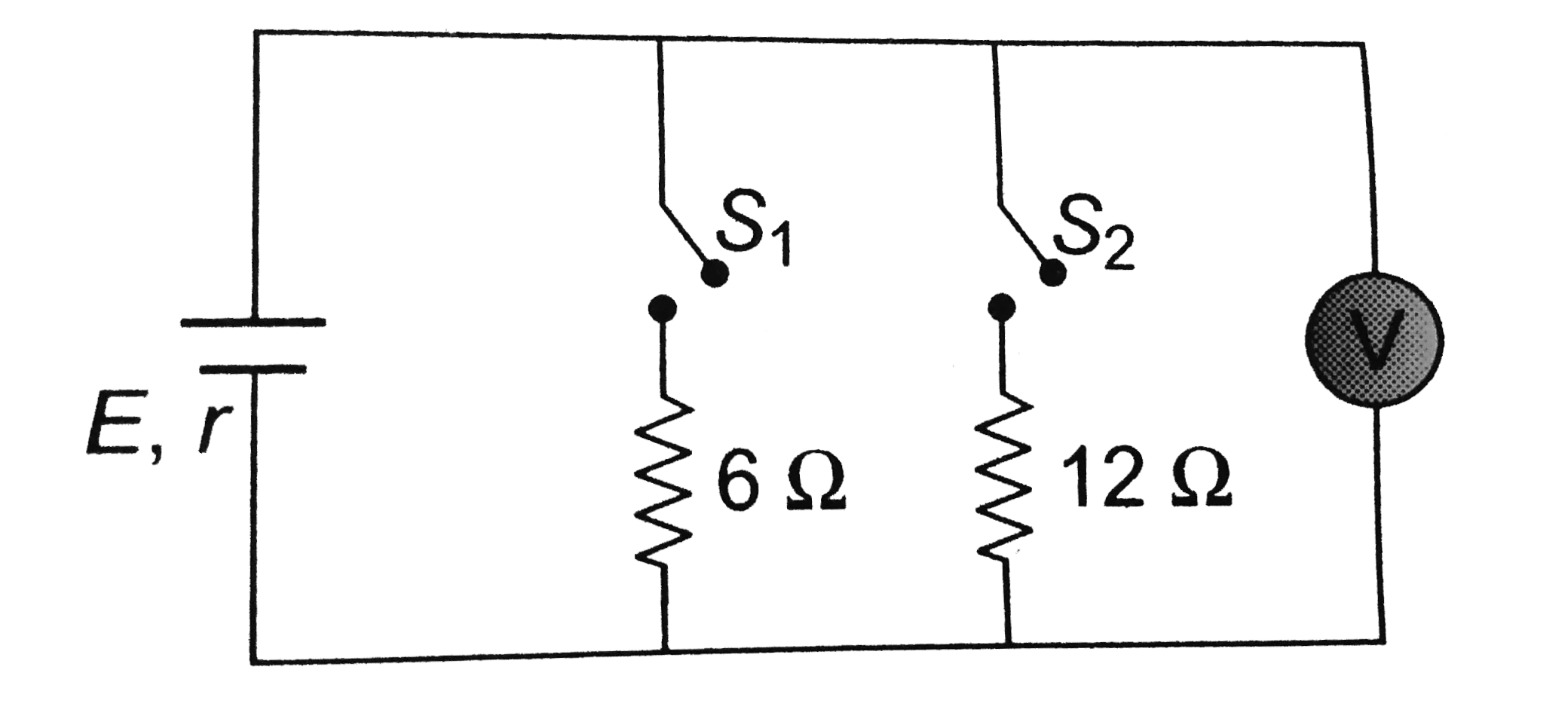
View SolutionIn the circuit shown in figure

View SolutionThe equivalent resistance across AB in the given network is

View SolutionThe n rows each containing m cells in series are joined in parallel. Maximum current is taken from this combination across anexternal resistance of `3Omega` resistance. If the total number pf cell used are 24 and internal resistance of each cell is `0.5Omega`, then
View SolutionThe equivalent resistance between points A and B is
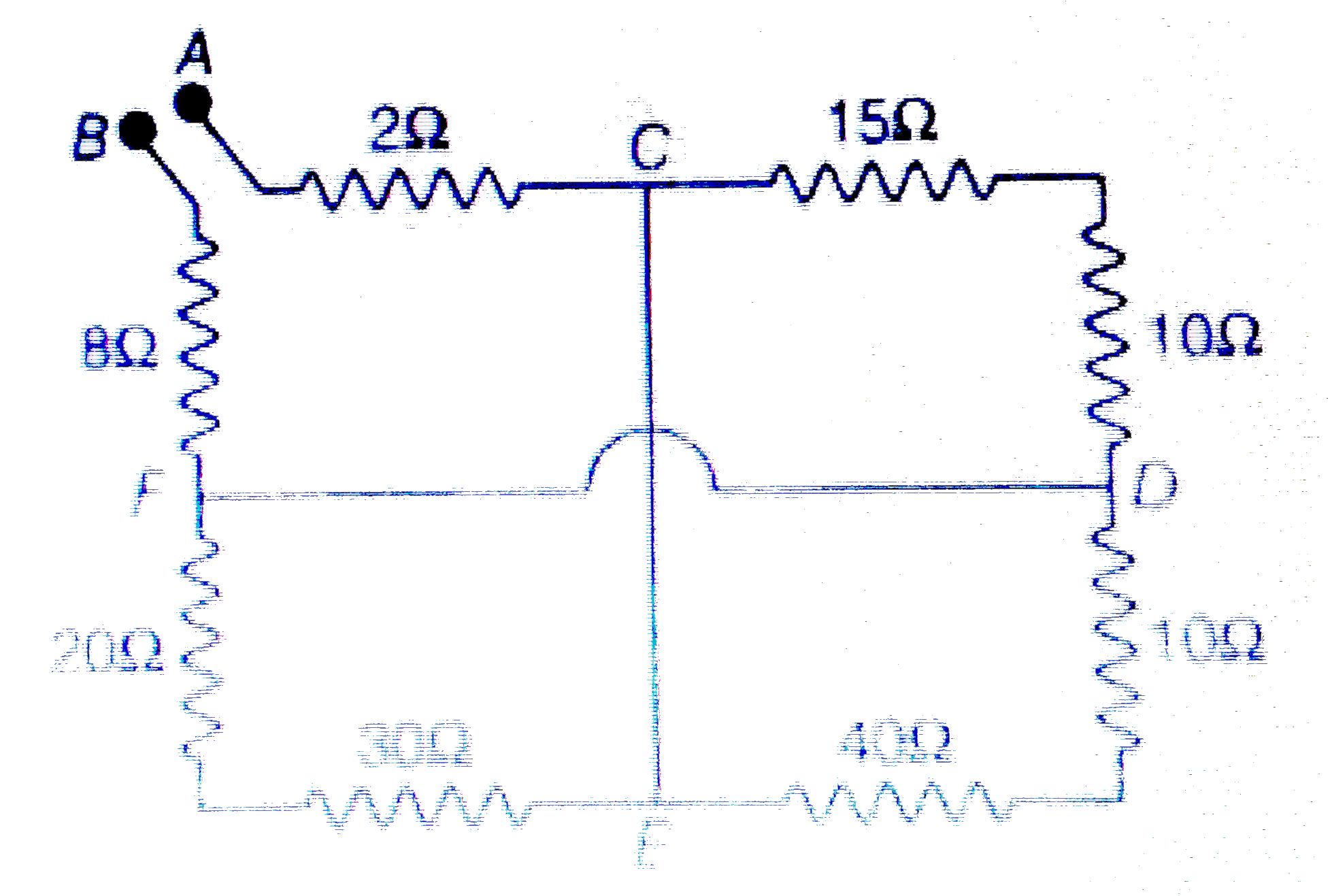
View SolutionA battery of internal resistance `4 Omega` is connected to he network of resistances as shown in Fig. `7.40`. In order that the maximum power can be delivered to the network , the value of `R` in ` Omega` should be
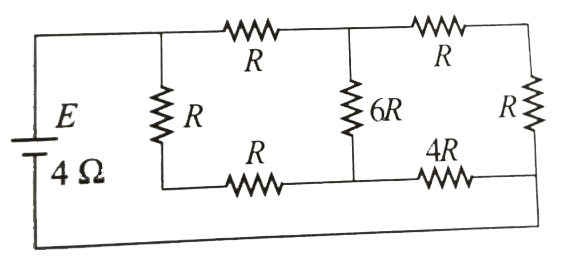
View SolutionIn the circuit shown in figure switch S can be shift to position A or position B. Current though resistance is say `i_(1)` when switch is in position. A and when switch is in position B, then

View SolutionA galvanometer has resistance G and full scale deflection current i. To convert this galvanometer into an ammeter of range 10 I, a shunt `S = (G)/(9)` is connected in parallel with G. Now we want to measure potential difference with the help of this ammeter. What is the maximum value of potential difference which can be measured with the help of this?
View SolutionFour resistance are connected to a DC battery as shown in figure. Maximum power will be developed across ......... Ohm resistance.
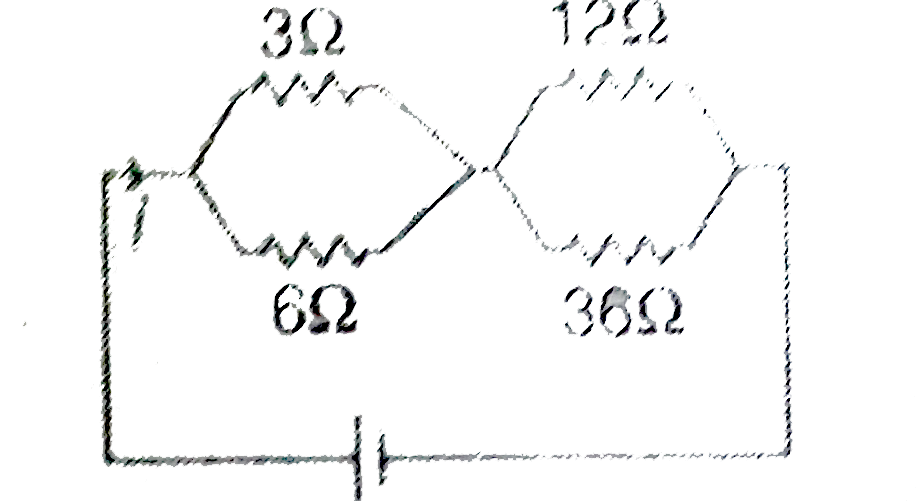
View SolutionA hollow cylinder of specific resistance `rho`, inner radius `R`, outer radius `2R` and length l is as shown in figure. What is the net resistance between the inner and outer surfaces?
View SolutionA group of identical cells (all in parallel) are connected to an external resistance `R_(1)`. Current through `R_(1)` is `i_(1)`. Another group of identical cells (all in series) are connected to some other resistance `R_(2)`. Current through `R_(2)` is `i_(2)`. Now one cell is removed from both the groups. Then
View SolutionFive identical cells are connected in parallel. Now, polarity of one of the cells is reversed. Percentage change in equivalent emf will be
View SolutionIn the circuir shown in figure, current is zero through

View SolutionIf internal resistance of a cell is proportional to current drawn from the cell. Then the best representation of terminal potential difference of a cell with current drawn from cell will be
View SolutionA galvanometer, together with an unknown resistance in series, is connected across two identical batteries of each `1.5 V`. When the batteries are connected in series,the galvanometer records a current of `1 A`, and when the batteries are connected in parallel, the current is `0.6 A`. In this case, the internal resistance of the battery is
View SolutionIn the figur shown, the thermal power generated in 'Y' is maximum when `Y = 4 Omega`. Then X is
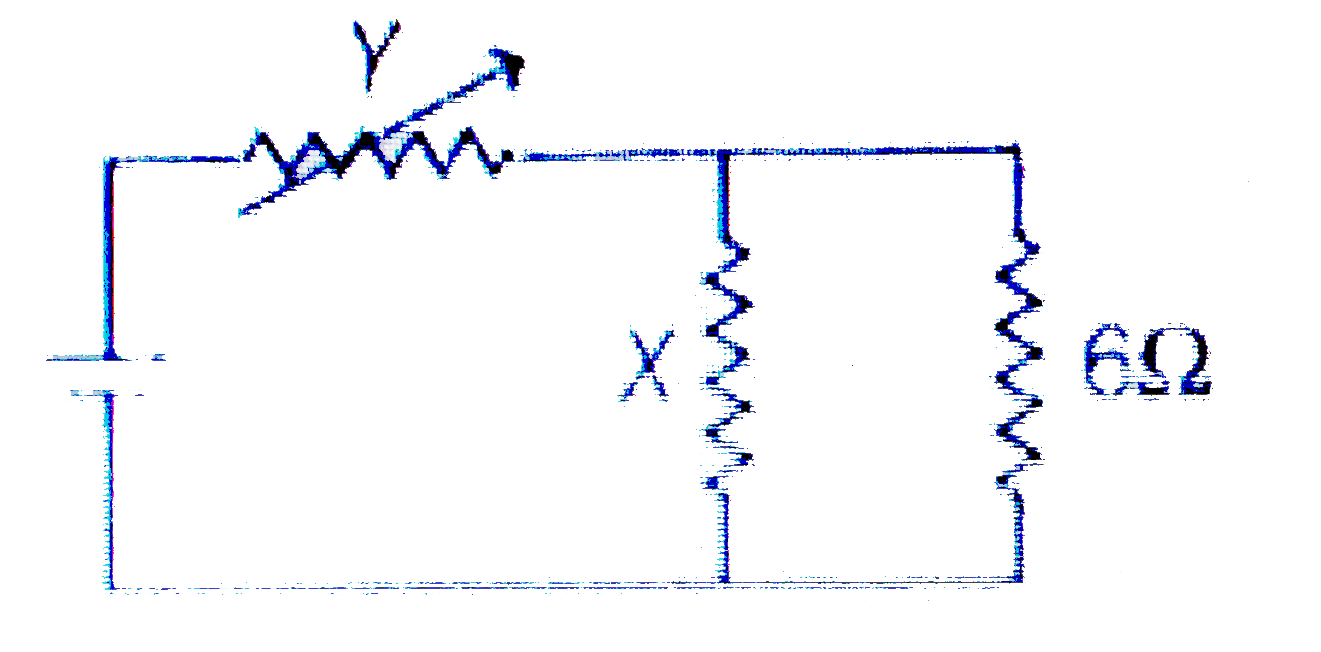
View SolutionA cell of emf E having an internal resistance R varies with R as shown in figure by the curve

View SolutionSix wires each of resistance r form a tetrahedron. The equivalent resistance between corners 1-2 and 1-3 are respectively

View SolutionA series parallel combination battery consisting of a large number `N = 300` of identical cells, each will an inernal resistance `r = 0.3 Omega`, is loaded with an external resistances `R = 10 Omega`. Find the number `n` of parallel groups consisting of an equal number of cells connected in series, at which the external resistance generates the highest thermal power.
View SolutionOne end of a Nichrome wire of length `2L` and cross-sectional area `A` is attached to an end of another Nichrome wire of length `L` and cross-sectional area `2A`. If the free end of the longer wire is at an electric potential of `8.0` volts, and the free end of the shorter wire is at an electric potential `1.0` volts, the potential at the junction of the two wires is equal to
View SolutionIn the circuit shown, the resistance are given ohms and the battery is assumed ideal with end equal to 3.0 volts. The resistance that dissipates the maximum power is

View SolutionIn the diagram, resistance between any two junction is R. Equivalent resistance acm terminas A and B is (assume P and Q also as juction)

View SolutionA battery of emf `E_(0) = 12 V` is connected across a `4 m` long uniform wire having resistance `(4 Omega)/(m)`. The cells of small
emfs `epsilon_(1) = 2 V` and `epsilon_(2) - 4 V` having internal resistance `2 Omega` and `6 Omega` respectively, are connected as shown in the figure. If galvanometer shows no deflection at the point `N`, the distance of point `N` from teh point `A` is equal to

View SolutionIn the circuit shown, what is the potential difference `V_(PQ)`?

View SolutionIn an experiment, a graph was plotted of the potential difference V between the terminals of a cell against the circuit current "I" by varying load rheostat, internal conductance of the cell is given by
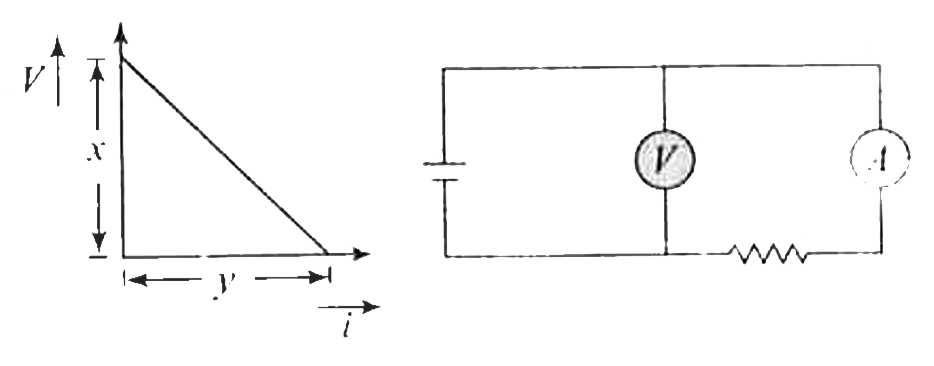
View SolutionIn the circuit, 8 resistors of `2 Omega` and 8 resistors of `4 Omega` are connected as shown in the figure. The current in the branch AB is

View SolutionA battery of emf E and internal resistance r is connected across a resistance R. Resistance R can be adjusted to any value greater than or equal to zero. A graph is plotted between the current passing through the resistance (I) and potential difference across the termainals of the battery (V). Maximum power developed across the resistance R is

View SolutionIn the circuit shown in figure, the ratio

View SolutionIn the circuit shown in figure

View SolutionA microammeter has as resistance of `100 Omega` and full scale range of `50 muA`. It can be used as voltmeter or as a higher range ammeter provided a resistance is added to it. Pick the correct range and resistance combinations
View SolutionIn the circuit shown in figure

View SolutionA voltmeter reads the potential difference across the terminals of an old battery as `1.40 V`, while a potentiometer reads its voltage to be `1.55 V`. The voltmeter resistance is `280 Omega`.
View Solution
All Questions questions and complete solutions for chapter CURRENT ELECTRICITY of DC PANDEY ENGLISH of Class 11